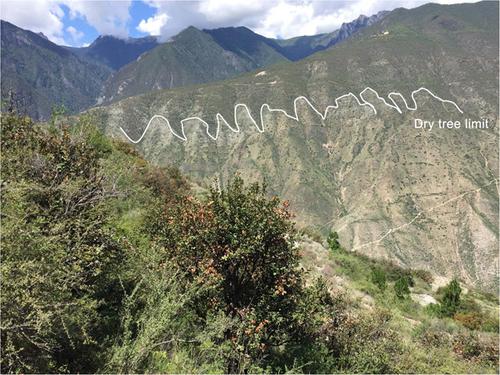当前位置:
X-MOL 学术
›
J. Syst. Evol.
›
论文详情
Our official English website, www.x-mol.net, welcomes your feedback! (Note: you will need to create a separate account there.)
Water relations of “trailing-edge” evergreen oaks in the semi-arid upper Yangtze region, SE Himalaya
Journal of Systematics and Evolution ( IF 3.7 ) Pub Date : 2020-10-12 , DOI: 10.1111/jse.12696 Xiao‐Fang He 1, 2 , Song‐Wei Wang 3 , Hang Sun 1 , Christian Körner 3 , Yang Yang 1
Journal of Systematics and Evolution ( IF 3.7 ) Pub Date : 2020-10-12 , DOI: 10.1111/jse.12696 Xiao‐Fang He 1, 2 , Song‐Wei Wang 3 , Hang Sun 1 , Christian Körner 3 , Yang Yang 1
Affiliation

|
Unlike the well-understood cold limit of trees, the causes of the dry trailing edge of trees await explanation. Here we aimed at explaining the drought limit of an evergreen oak species (Quercus pannosa s.l.) in a typical dry valley of the upper Yangtze region, SE Himalaya, where rains (ca. 250 mm/a) are largely confined to the typical monsoon season (July–August) with drought during the remaining 9–10 months. We capitalized on an unintentional year-round irrigation treatment with trees growing along the overflow of a water reservoir serving as moist controls. We measured shoot water potential (Ψ), leaf conductance (g), flushing phenology, leaf mass per area (LMA), foliar and stem δ13C, leaf nutrients, and non-structural carbohydrates across the transition from non-monsoon to monsoon season, from April to August 2018. At the dry site, Ψ and g were high during the monsoon but declined to <−3 MPa as drought proceeded in the non-monsoon season. Irrigated oaks retained high values year-round. Oaks experiencing the natural drought flushed at the full strength onset of the monsoon only, that is, 80 days later than irrigated oaks. The annual shoot increment in oaks under natural drought was ca. 10% of that in irrigated oaks. However, mature foliage showed no difference in LMA and δ13C between dry and moist sites. We conclude that these oaks drastically reduce their activity in response to drought, with growth strictly confined to the monsoon season, the minimum duration of which, presumably is setting the range limit.
中文翻译:

喜马拉雅东南部半干旱长江上游地区“后缘”常绿橡树的水分关系
与众所周知的树木寒冷极限不同,树木后缘干燥的原因有待解释。在这里,我们旨在解释常绿橡树种 ( Quercus pannosa sl) 在上扬子地区喜马拉雅东南部典型干旱河谷的干旱极限,那里的降雨量(约 250 毫米/年)主要限于典型的季风季节(7 月至 8 月)在剩余的 9 至 10 个月内出现干旱。我们利用了一种无意的全年灌溉处理,沿着水库的溢流生长的树木作为潮湿控制。我们测量了芽水势 (Ψ)、叶电导 (g)、潮红物候、单位面积叶质量 (LMA)、叶和茎 δ 132018 年 4 月至 2018 年 8 月,从非季风季节过渡到季风季节期间的 C、叶片养分和非结构性碳水化合物。在非季风季节。灌溉橡树全年保持高价值。经历自然干旱的橡树仅在季风全面爆发时冲洗,即比灌溉橡树晚 80 天。自然干旱下橡树的年芽增量约为。其中 10% 在灌溉橡树中。然而,成熟的叶子在 LMA 和 δ 13 方面没有差异C 在干燥和潮湿的地方之间。我们得出的结论是,这些橡树在应对干旱时会大幅减少其活动,其生长严格限于季风季节,其最短持续时间大概是设定范围限制。
更新日期:2020-10-12
中文翻译:

喜马拉雅东南部半干旱长江上游地区“后缘”常绿橡树的水分关系
与众所周知的树木寒冷极限不同,树木后缘干燥的原因有待解释。在这里,我们旨在解释常绿橡树种 ( Quercus pannosa sl) 在上扬子地区喜马拉雅东南部典型干旱河谷的干旱极限,那里的降雨量(约 250 毫米/年)主要限于典型的季风季节(7 月至 8 月)在剩余的 9 至 10 个月内出现干旱。我们利用了一种无意的全年灌溉处理,沿着水库的溢流生长的树木作为潮湿控制。我们测量了芽水势 (Ψ)、叶电导 (g)、潮红物候、单位面积叶质量 (LMA)、叶和茎 δ 132018 年 4 月至 2018 年 8 月,从非季风季节过渡到季风季节期间的 C、叶片养分和非结构性碳水化合物。在非季风季节。灌溉橡树全年保持高价值。经历自然干旱的橡树仅在季风全面爆发时冲洗,即比灌溉橡树晚 80 天。自然干旱下橡树的年芽增量约为。其中 10% 在灌溉橡树中。然而,成熟的叶子在 LMA 和 δ 13 方面没有差异C 在干燥和潮湿的地方之间。我们得出的结论是,这些橡树在应对干旱时会大幅减少其活动,其生长严格限于季风季节,其最短持续时间大概是设定范围限制。


























 京公网安备 11010802027423号
京公网安备 11010802027423号